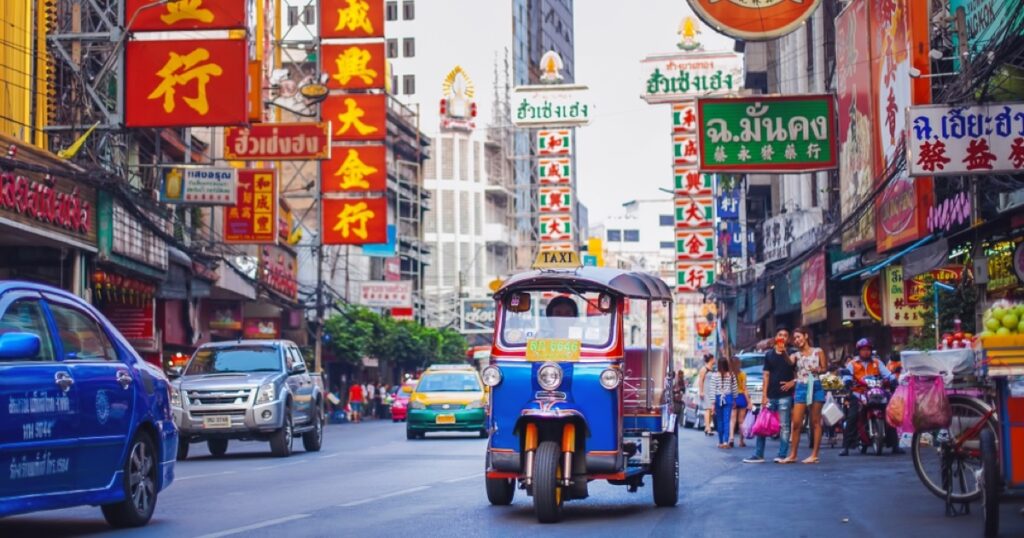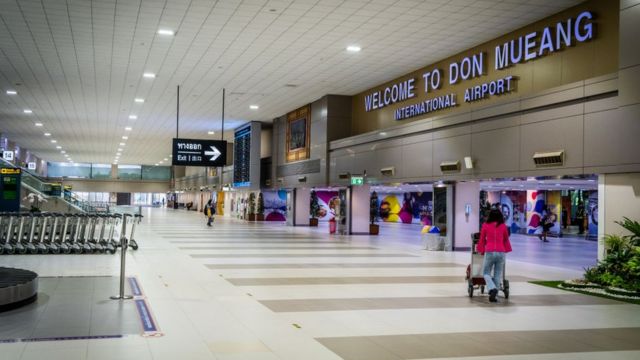Solo travel is an emerging trend in the tourist industry. Not only does it appeal to introverts, but solo travel also sparks the curiosity of many other avid travelers. One of the best aspects of solo travel is that it takes you out of your comfort zone and gives you the chance to discover new places and interact with interesting people from all walks of life. In essence, traveling alone is a journey into your inner self as well as a voyage to see the world.
Thailand is one of the best vacation destinations for solo travelers. The details for your particular solo travel experience, including modes of transportation, areas to stay in, and must-see locations, are provided here. All these are designed for your ultimate solo travel experience, filled with activities that are fun, enjoyable, and safe. Without further ado, let’s dive into the details.
Get to Know Bangkok: Walk the City’s Old Neighborhoods
Bang Rak-Charoen Krung



Located on the bank of the Chao Phraya River, Bang Rak District on Charoen Krung Road is one of the oldest cultural and financial hubs in Thailand. The neighborhood is a short distance from the city’s major trading hubs, including Yaowarat and Talad Noi. Charoen Krung Road is the first road ever built in Thailand. In essence, the modern city of Bangkok sprawled out of this area, to which many other streets and roads are connected.
Area Highlights
- Walk the neighborhood: admire the stunning architectures, such as the Holy Rosary Church and the Grand Postal Building. Take in the street art and cultural heritage of Talad Noi, one of Bangkok’s oldest neighborhoods.
- Take a cruise at River City Bangkok, Si Phraya pier: see the sunset, and enjoy the scenery of the Chao Phraya River at night.
- Indulge in a food tour along Yaowarat Road and end the night in the nearby Soi Nana for a sip of delectable cocktails in a Thai-inspired ambiance fused with traditional Thai tunes and aromatic incense.




How to Get There
- From Suvarnabhumi International Airport: Take the Airport Rail Link to Phaya Thai station, then change to the BTS sky train and get off at Saphan Taksin station. The total commute time is about an hour.
- From Don Mueang International Airport: Take the Red Line commuter train to Bang Sue station, then change to the MRT Blue Line, exiting at Hua Lamphong station. The total commute time is about an hour.


Ratchathewi and Phayathai
These bustling areas are right at the heart of the city, where shopping complexes such as Siam Square are just a stone’s throw away. The Ratchathewi and Phayathai districts, which are considered the heart of modern Bangkok, also serve as meeting places for traditional and contemporary arts.
Area Highlights
- See street art in Chaloemla Gardens, a park in the heart of the city where street artists have transformed the walls of historic buildings into canvases.
- Visit Baan Krua community, home to a group of Cambodian Muslims with a 240-year heritage. See the first mosque ever built in Bangkok and learn traditional silk weaving from the last family of traditional silk weavers in the area.
- Visit Jim Thompson House Museum, which is housed in a lovely traditional Thai wooden house, and select your favorites from a selection of real Thai silks in a variety of colors and patterns.
- Get a healthy dose of art therapy at Studio Persona.
- See contemporary artworks at Bangkok Art & Culture Centre.
- Shop and dine at Bangkok’s leading shopping centers such as Siam Square, Siam Paragon, and MBK Center, and sample a variety of Thai craft beers in Phayathai.



How to Get There
- From Suvarnabhumi International Airport: Take the Airport Rail Link to Phayathai station, then switch to a BTS sky train, exiting at Ratchathewi station. The total commute time is about 40 minutes.
- From Don Mueang International Airport: Take an A2 bus to the Victory Monument, then take a BTS sky train to Ratchathewi station, which is 2 stops away. The total commute time is about 40 minutes.
Explore the Regional Wonders of Thailand
The six regions of the Kingdom of Thailand are the Central, North, South, West, East, and Northeast. Each region has distinctive geographical characteristics. Here are some recommendations for lone travelers seeking a diversified and balanced cultural and natural experience.
The North:
The breathtaking mountains and rolling hills that encompass the entirety of Northern Thailand are the region’s finest assets. The climate here is often cooler than the rest of the nation. Some of the most unforgettable experiences you can have when visiting the region include waking up to the dawn amidst the morning mist, stargazing at night, and learning the ways of the ethnic hill tribes. Our recommended destinations are Doi Inthanon and Mon Jam in Chiang Mai province and Phu Langka National Park in Payao province.
Highlights
- Phu Langka: Admire the sea of mist hovering over scattered peaks of limestone mountains at 900–1,720 meters above sea level.
- Nature tour: Walk a nature trail and see rare birds and wild orchids. Take a dip in Phu Langka Waterfall and visit Lan Hin Lan Pee, a plateau on the top of Phu Lanka.
- Take a two-hour detour to the district of Chiang Khong in Chiang Rai province, a quaint little town on the bank of the Mekong River opposite the Lao PDR.

How to Get There
- We recommend taking a flight from Don Muang International Airport to Chiang Rai International Airport. Then drive to Phu Langka National Park in Pha Chang Noi, Pong District. The road trip takes no more than 3 hours.
- The best time to visit is during the colder season, from November to February.
The South:
Ocean and islands are the defining characteristics of southern Thailand. The South is blessed with crystalline blue water and a profusion of marine life due to its abundance of natural resources. On the beach, you can engage in sports such as snorkeling, kayaking, and sunbathing. Popular destinations include Koh Lanta and Koh Jum in Krabi province, the Similan Islands in Phuket province, and Samet Nangshe viewpoint in Phang-nga province.
Samet Nangshe Highlights
- See limestone formations in various shapes and sizes from Samet Nangshe’s viewpoint.
- Take a speedboat to Phang Nga Bay, see mangrove forests, and observe the lives of local southerners along the coastline.
- Take a speedboat to Koh Tapu (James Bond Island), where you can see Thailand’s first floating football field and eat delicious seafood made by the Muslim villagers of Ko Panyi.

How to Get There
- Take a flight from Don Mueang International Airport to Phuket International Airport. Then drive to Samet Nangshe in Khlong Khian, Takua Thung District, Phang-nga province. The road trip takes approximately 50 minutes.
- The best time to visit is during the summer, from March to August.
The West:
This region’s primary attractions are its stunning mountains and dense forests. Western Thailand is an unmissable destination for travelers who enjoy camping and adventures. In addition to well-known tourist destinations such as the seaside town of Hua Hin, this region features a number of other worthwhile destinations, such as Kaeng Krachan National Park in Phetchaburi province, Kui Buri National Park in Prachuap Khiri Khan province, and Erawan Falls in Kanchanaburi province.
Kaeng Krachan Highlights
- Camping in nature at Kaeng Krachan National Park, the largest tropical rainforest in Thailand. See countless colorful butterflies at Lan Hin Kwang.
- Watch the sunrise amidst the sea of mist at Khao Phanoen Thung. During the daytime, take photos at the rope bridge in Kaeng Krachan Dam. At night, stargaze while cozying up next to a fire pit.
- Paddle a kayak or raft along the Phetchaburi River, which is surrounded by breathtaking jungle landscapes.

How to get to Kaeng Krachan, Phetchaburi province
- We recommend you drive or take public transport from Bangkok to Kaeng Krachan National Park in Kaeng Krachan district, Phetchaburi province. The road trip takes no more than three hours.
- You can visit Kaeng Krachan all year round. However, we recommend visiting during the colder season, from November to February, when you are likely to see the sea of mist.
The East:
TheEast of Thailand is a region with diverse landscapes: the seas, the lakes, the rivers, and the plateaus. The eastern coast of Thailand, like the southern coast, boasts one of the most beautiful coastlines and an abundance of marine resources. The Northeast (Isaan region) boasts stunning mountains and beautiful architectures and is the birthplace of everyone’s favorite dish, the papaya salad, or Som Tum. Some of the top destinations in the Northeast and the East are Sam Phan Bok and Pha Taem in Ubon Ratchathani province and Koh Mak and Koh Chang in Trat province.
Highlights at Pha Taem National Park
- View Thailand’s “first light” and the sea of mist at Pha Chana Dai, Pha Taem National Park.
- Go on nature trails; visit Sao Chaliang, a nature park famous for its mushroom-shaped sandstone formations; trek to Pha Sok viewpoint overlooking the Mekong River; visit Thung Na Mueang Waterfall; and see prehistoric cave paintings in the national park.
- See the Milky Way (Pha Taem is one of the 12 locations across Thailand registered as a Dark Sky Park where travelers can stargaze under a clear sky).

How to Get There
- We recommend taking a flight from Don Mueang International Airport to Ubon Ratchathani International Airport. Then drive to Pha Taem National Park in Huai Phai, Khong Chiam District. The road trip takes no more than two hours.
- The best time to visit is during the colder season, from November to February.
Photo Credit:
- https://thailandtourismdirectory.go.th/
- https://th.tripadvisor.com/
- https://www.eventpop.me/
- https://pantip.com/topic/38065950
- https://www.tourismchiangrai-phayao.com/
- https://thai.tourismthailand.org/
Share




